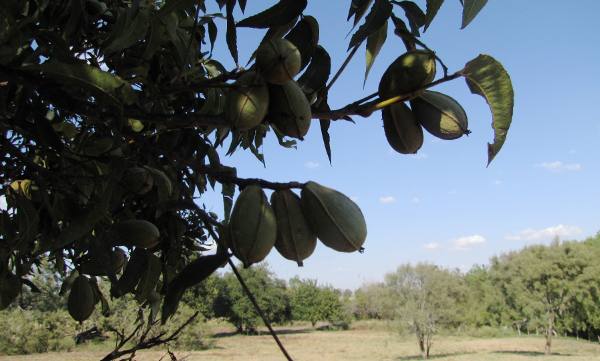
While drought conditions and a shortage of irrigation water in many cases has stressed Southwest pecan crops for a third year in a row, reports about condition and harvest prospects are mixed as growers hold on to hope of a successful year in spite of the challenges.
July rainfall across large areas of Texas and beneficial showers in south and southeastern New Mexico have provided some relief from dry summer conditions and have helped to lower heat stress in trees. But with early harvest still two to three months away, many challenges remain for commercial growers.
In New Mexico it appears to be an on-year in pecan’s alternate bearing production cycle for most growers. While irrigation allotments from both the Rio Grande and Pecos Rivers have been extremely limited, application of ground water irrigation appears to have been sufficient so far to sustain trees and the current nut crop. Pest pressure from aphids and pecan nut casebearers has been light to moderate in most high-production areas.
New Mexico State University Extension Service is reminding pecan growers that August is a good time to check for nitrogen levels by performing leaf analysis to determine if nitrogen is required to guarantee kernel fill. Nitrogen requirements and application schedules are different for on-year/off-year production cycles. During off-years nitrogen application is generally limited to critical times for leaf and shoot growth in the spring; on-year nitrogen is also required in September if leaf tissue concentrations fall below 2 percent to 3 percent.
If you are enjoying reading this article, please check out Southwest Farm Press Daily and receive the latest news right to your inbox.
According to an Extension bulletin, proper levels of nitrogen not only improves nut quality but also assists winter survival of trees and promotes fruit set the following year.
In pecan-rich Eddy County, Carlsbad Irrigation District officials say recent rains came at the right time for pecan and cotton growers. Irrigation allotments are extreme low this year, but CID officials say if monsoon rains continue, they may increase allotments slightly in August. So far, pecan growers have mostly been required to rely on groundwater to sustain their orchards.
Texas
In Texas, hot dry conditions, coupled with drought from the previous two years, have made it a difficult year for trees in what is generally believed to be an off-year in the production cycle. In spite of a light nut load reported by most commercial growers across the state, they continue to worry about defoliating insect and disease pressure. In some areas of the state, black pecan aphids were reported in June, several weeks ahead of schedule. Growers should watch for black aphids in crowded/shaded areas and in the center portion of the canopy.
Also of concern in Texas are reports of migrating grasshoppers. Bill Ree, Texas A&M Extension Program specialist for pecans, recommends creating buffer zones around orchards if grasshoppers are not yet spotted in the canopy.
"My general recommendation is to treat the orchard floor, fence lines, ditch banks or any area that could provide a buffer zone between the hordes of migrating grasshoppers and your trees," he says.
But he cautions growers to be mindful of ground treatment where livestock graze around the trees.
Once grasshoppers are spotted in the canopy, an application of a broad spectrum insecticide may be required, but Ree also warns that frequent foliar applications can create problems with aphids, mites and even leafminers.
Another pest of concern across parts of Texas includes a second generation of walnut caterpillar. Walnut sphinx caterpillars also have caused problems in Central Texas this year, but not the degree experienced in the 2012 crop.
While pecan specialists warn it is too early to accurately estimate crop production levels for 2013, a check across the largest pecan producing states provides a peek at what producers are expecting, provided the current crop progresses through the second half of the growing season at the same level it did the first half of the year.
Most agree that overall U.S. production should be in the neighborhood of 220 million pounds this year. While Georgia is once again expected to produce the largest crop, scab problems there likely will be a limiting factor in crop size and production. Overall, Georgia is expected to produce about 85 million pounds.
New Mexico is expected to capture the number two spot of overall U.S. production with an estimated 52 million pounds, and Texas is expected to follow with 30 to 32 million pounds for the year.
Also of interest:
Pecan Newsletter offers peek at 2013 Texas pecan season
Stinkbug heads to Texas and threatens fruits, nuts and row crops
Sanitation is critical for grain bin pest management
About the Author(s)
You May Also Like




